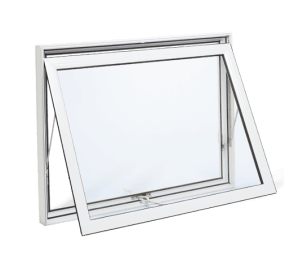Awning Windows

Awning windows are designed so that the window swings out open from the bottom, rather than sliding up or down or tilting inward. This design was popular before the advent of air conditioning but is still used today in homes for ventilation and lighting.
Nuts and Bolts
The awning window is a basic sash (window pane) and frame construction. The window can have one sash filling the frame, or be made of several smaller sashes. Top-mounted hinges allow the window to swing out, and this motion is achieved by use of an interior hand crank or chain.
Typically, awning windows are wider than they are tall. However, because the window opens outward from the bottom, they can be made most any size to fit most spaces. These windows are often placed over a door or another window.
Pros and Cons
As with most windows, there are positive and negative factors to weigh when considering awning windows.
On the pro side, awning windows are designed for improved room ventilation and lighting. These windows are made to fit in rooms from large to small. They are designed to catch the breeze, and because they swing out from the bottom, these windows can be opened in most weather conditions. Awning windows also allow more natural light into rooms because they can be used in smaller spaces or stacked on top of on another or over doors.
One of the drawbacks to awning windows is that they need frequent cleaning. Since the screen is on the inside, instead of on the outside, more dust and dirt can get into the room, resulting in more cleaning inside as well. Finally, because the window swings out, it may obstruct outside walkways.
Bottom Line
Awning windows are good for providing light and ventilation in dark, stuffy rooms, and because of their design, they can be used in small rooms. These windows can be used year-round fro cooling in more moderate climates.





 High Energy Star Rating
High Energy Star Rating Lifetime Warranty
Lifetime Warranty